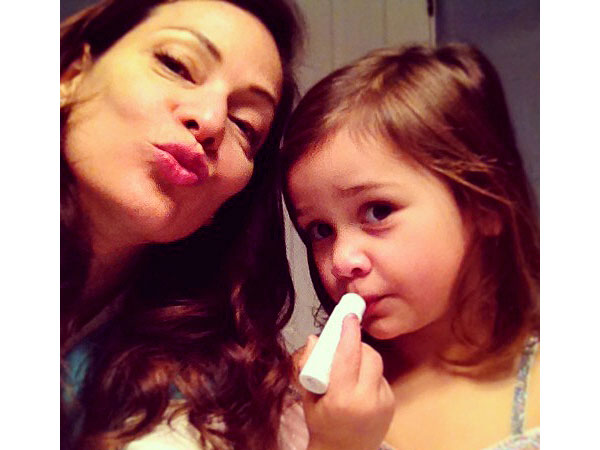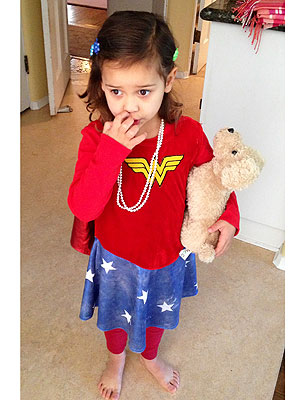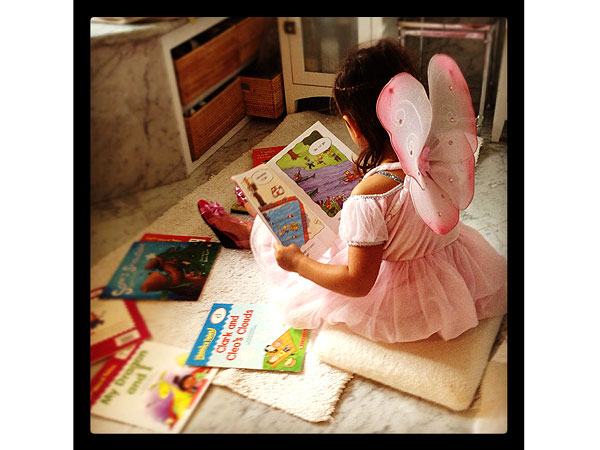Look who’s back! We’re thrilled to say hello again to Constance Marie, our original celebrity blogger!
The actress, mom to daughter Luna Marie, 4 on Tuesday, with fiancé Kent Katich, stars on Switched at Birth, airing Mondays at 8 p.m. ABC Family.
She’s also one of the celebrity voices narrating beloved children’s stories for Little Golden Records, available now at Walmart.
Marie, 47, can also be found online on Facebook and @goconstance on Twitter. If you’ve missed any of her past posts, check them out here.
In her latest blog, the actress explains why she decided to drop her anti-princess stance and accept it instead.

Getting lippy with my girl – Courtesy Constance Marie
Oftentimes, my blogs start with a confession. This one is no different. My name is Constance Marie and I am anti-princess.
That’s right, I said it. I am anti-princess. Well, I guess the more correct statement would be: I was anti-princess.
And here is my reasoning: Many of the old princess stories emphasize beauty, wardrobe and much too much emphasis on how you look on the outside! To me, this was a recipe for shallow thinking and way too many opportunities for me to squander my money on accessories.
So when Luna Marie was young, I thought, “I am not having any of that!” I was a tomboy as a child! I much wanted my daughter to be a scrapper and not so dainty.
But then I was snapped back to reality. I realized my daughter did not live in a bubble. She wasn’t so little anymore and she heard princess stories EVERYWHERE!!! All her friends, all the kids from school … everyone had dress-up clothes, tiaras, wands, plastic shoes, stickers and books.
Like I said — EVERY-frickin-where!!! It was like a princess avalanche that I could not stop, no matter how much I tried to avoid it. Oh yes. It was a losing battle … I did not stand a chance.
So, I set myself down and had a good think. I mean, all her friends were on the princess train. I didn’t want my daughter to feel left out. We’re not Amish for gosh sakes! So I sucked it up and started with one princess dress. Then of course, I saw another one in a different color. And then there was this sparkly one that was SO cute!
It was as if I had been bitten by the princess bug too! I thought to myself, “Okay, I’ll just dabble a little. Not too much princess. I’ll balance it with a little bit of doctor dress-up and superhero dress-up. I even succeeded in distracting her with a Wonder Woman outfit — ka-pow! I was so impressed with myself! At least for a little while.

My little Wonder Woman – Courtesy Constance Marie
Then … it happened. We were invited to a party and lo and behold, it was — you guessed it — a princess-themed party. With a real, live, human princess dressed in all the sparkle and flowery regalia that they wear! My daughter and I were done for. Seriously, she walked around like a dazed zombie just staring at this princess, adoring her from afar because she was too shy to go up close. Princesses 1, Mama 0.
Once again I sat down and had a good think. I realized this anti-princess battle was not going to be won by me.
FYI — I don’t take losing very well. I was a tomboy, remember — a scrapper. In all honesty, I loved to win! These princesses were not going to take me down! At least not without a proper battle.
I may have not be able to avoid this princess vortex, but I was going to find a way to spin this princess thing to my advantage — even if I had to choke down a tiara or two.
After many hours of analyzing my options, I realized most often the princesses started in non-fancy clothes, had to deal with a lot of adversity, and in the end they always came out on top. They may not have looked like princesses on the outside, but inside their behavior was totally princess-like.
Ha ha, I said to myself. I have my hook! Being a princess is all about how you behave and how you are on the INSIDE! I mean they weren’t all bad … most often them have a positive attitude. They are kind to animals. They are brave. They work hard. They tolerate adversity pretty well. And they have excellent manners! So I decided to teach my daughter that being a princess was more than what you wear or how you look.
I forgot to mention that this princess thing happened at around age 3.5. As I mentioned in a previous blog, we never got the terrible twos, but we got HIT by the terrible threes!
As luck would have it, I found a book called Polite as a Princess. It was perfect. Every parent’s dream! It had all the well-known princesses and it talked about how they had manners. They said, “Please” and “Thank you,” they didn’t interrupt, they shared — yada yada yada. The terrible threes were about to be over! (Insert diabolical laughter here).

Reading with wings – Courtesy Constance Marie
As parents, we have to use every tool that we can find, right?! We’re way older and don’t have as much stamina as they do!
So I implemented my plan. If I couldn’t fight the princesses, I was going to use them to help squash the terrible threes.
I read this book to my daughter at every opportunity. At the dinner table, in the car, before bed, potty time. She (and I) had it memorized. NOW I was ready to do battle!
At any time there was behavior that was basically driving me insane — behavior that I had tried to correct like 300 times before, but to no avail — I could quote the princess book. “Does Snow White get up in the middle of a meal?” “Is Ariel good at sharing?” etc.
This line of questioning would stop my daughter in her tracks. Luna Marie wanted NOTHING MORE than to be like a princess! She would look at me stunned/tortured as if I had some kind of special power.
And like a brainwashed little soldier, she immediately behaved like a proper princess. She would sit still,, she would use her napkin,, she would share. It was amazing! I was almost drunk with power!!! Princess 1 – Mama 47!
I know … it does sound a little “evil step mother-y” but come on, a mama’s gotta do what a mama’s gotta do.
So now, when we are out getting our playdate on, or somewhere in public, strangers often compliment me on my daughter’s manners. To which I look at them, and say a polite princess, “Thank you” and then with a little twinkle in my eye I say, “Let me tell you about my philosophy, but more importantly this book!”

Meeting a princess in person – Courtesy Constance Marie
The parent’s response? “I REALLY gotta go get that book!”
So now, I’m just trying to pay it forward. Sadly, word on the street is that there is no boy equivalent for this book, like Polite as a Prince or Polite as a Pirate — wait, that last one doesn’t make sense.
Anyhoo, maybe some day there will be! Till then, Stay strong Mommies and Daddies!
– Constance Marie
More from Constance’s PEOPLE.com blog series:














